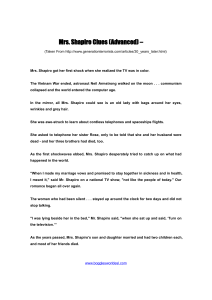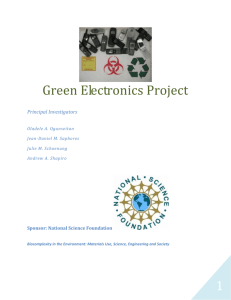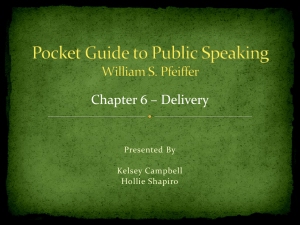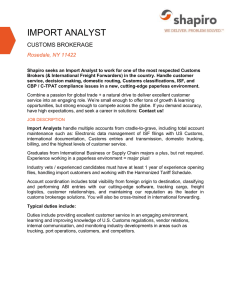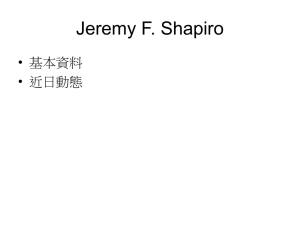Document 10498434
advertisement
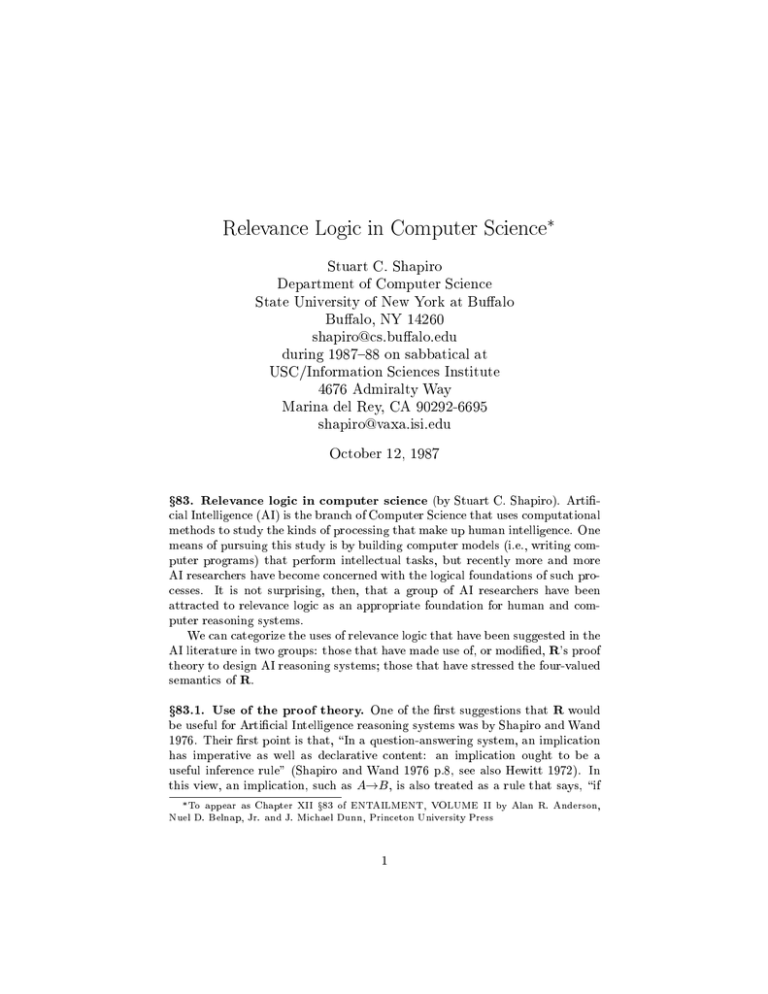
Relevane Logi in Computer Siene
Stuart C. Shapiro
Department of Computer Siene
State University of New York at Bualo
Bualo, NY 14260
shapiros.bualo.edu
during 1987{88 on sabbatial at
USC/Information Sienes Institute
4676 Admiralty Way
Marina del Rey, CA 90292-6695
shapirovaxa.isi.edu
Otober 12, 1987
Relevane logi in omputer siene (by Stuart C. Shapiro). Artiial Intelligene (AI) is the branh of Computer Siene that uses omputational
methods to study the kinds of proessing that make up human intelligene. One
means of pursuing this study is by building omputer models (i.e., writing omputer programs) that perform intelletual tasks, but reently more and more
AI researhers have beome onerned with the logial foundations of suh proesses. It is not surprising, then, that a group of AI researhers have been
attrated to relevane logi as an appropriate foundation for human and omputer reasoning systems.
We an ategorize the uses of relevane logi that have been suggested in the
AI literature in two groups: those that have made use of, or modied, R's proof
theory to design AI reasoning systems; those that have stressed the four-valued
semantis of R.
x83.
x83.1. Use of the proof theory. One of the rst suggestions that R would
be useful for Artiial Intelligene reasoning systems was by Shapiro and Wand
1976. Their rst point is that, \In a question-answering system, an impliation
has imperative as well as delarative ontent: an impliation ought to be a
useful inferene rule" (Shapiro and Wand 1976 p.8, see also Hewitt 1972). In
this view, an impliation, suh as A!B , is also treated as a rule that says, \if
To
appear as Chapter XII
x83
of ENTAILMENT, VOLUME II by Alan R. Anderson,
Nuel D. Belnap, Jr. and J. Mihael Dunn, Prineton University Press
1
you want to know the truth of B , hek the truth of A." If A is irrelevant to B
(the worst ase being that A is a ontradition), this is not a reasonable rule.
Shapiro and Wand modify the notation of FR!& (x27.2) to eliminate the
sub-proof struture. They suggest that the knowledge base (KB) of a reasoning
system be onsidered to ontain \assertions of the form hA; '; i, where A is
some formula, ' 2 f0; 1g, and is a set." (The angle brakets were not in the
original.) The rules of inferene they present are:
hyp: hA; 0; fkgi may be added to the KB as long as fkg is a singleton set suh
that no assertion of the form hB; 0; fkgi is already in KB.
add: hA; 0; fkgi may be removed from KB and replaed by hA&B; 0; fkgi.
!E: If hA; '; i 2 KB and hA!B; ; >i 2 KB, then hB; 1; [ i may be
added to KB.
!I: If hA; 0; fkgi 2 KB and hB; '; i 2 KB and k 2 , then hA!B; 1; fkgi
may be added to KB.
&E: If hA&B; '; i 2 KB, then hA; 1; i may be added to KB and hB; 1; i
may be added to KB.
&I: If hA; '; i 2 KB and hB; ; i 2 KB, then hA&B; 1; i may be added to
KB.
Using the later terminology of Martins and Shapiro (see x83.1.1 below), we may
refer to ' as the origin tag and as the origin set of the assertion. All assertions
whose origin tags are 0 are hypotheses entered into the KB by some user. All
assertions of the form hA; 1; i are derived assertions whih have been derived
under the set of assumptions fhB; 0; fkgi j k 2 g.
Shapiro and Wand disuss the use of their system for using hypothetial
reasoning to derive new rules:
Consider a universe of disourse, , and the new, hypothetial world
produed by assuming hP; 0; fpgi. If, in this hypothetial world, we
an derive hQ; 1; [ fpgi, we an then derive the new dedution
rule hP !Q; 1; i in the original universe by use of !I. This is a
produtive rule in the sense that if we later learn that hP; '; i is
true, we an derive hQ; 1; [ i. . . . The rules of FR!& are preisely
the right ones to ensure that any derived [rules℄ are in fat relevant
to the hypothetial situation. (pp. 16{17)
Shapiro and Wand also use origin sets to dene the notion of a ontext : \A
ontext is a set and is said to ontain the set of assertions fhA; '; i j g"
(p. 15). They point out, in the light of suggestions made by Shapiro 1971 (pp.
107{109), that the rules of FR!& an be used to keep ontraditory ontexts
separate and that origin sets an be used to disover and remove the soure
2
of ontraditions if any arise during reasoning. These ideas were subsequently
key ideas in Belief Revision systems and Assumption-based Truth Maintenane
systems (see below).
SWM. The work of Shapiro and Wand 1976 was ontinued by Martins and Shapiro, whose work is desribed in a series of papers (Martins 1983;
Martins and Shapiro 1981, 1983, 1984, 1986a, 1986b, 1986, 198+a, 198+b; see
also Martins 1987). The logi developed by Martins and Shapiro, alled SWM,
operates on supported ws, whih are expanded versions of the assertion triples
of Shapiro and Wand, and whih we shall here refer to as assertions. An SWM
assertion A is a quadruple, hA; ; ; i, where A is a w alled the w of A, is
a member of the set fhyp, der, extg, and is alled the origin tag (OT) of A, is
a set of ws and is alled the origin set (OS) of A, and is a set of sets of ws
and is alled the restrition set (RS) of A. If A is the assertion hA; ; ; i, the
funtions w, ot, os, and rs are dened so that w(A) = A, ot(A) = , os(A)
= , and rs(A) = . (The notation in most of Martins and Shapiro's papers
diers slightly from that given here.)
A set of hypotheses, , is known to be inonsistent as soon as an assertion
is derived whose w is a ontradition and whose os is , or as soon as two
assertions, A1 and A2 , are derived for whih w(A1 ) = w(A2 ) and =
os(A1 ) [ os(A2 ). The rules of inferene of SWM guarantee that for every
derived assertion A, os(A) ontains every hypothesis w that was used in A's
derivation and only those hypothesis ws and that rs(A) ontains every set of
hypothesis ws known to be inonsistent with os(A). The rules of inferene do
not allow the derivation of any assertion A for whih os(A) would be a set of
hypothesis ws already known to be inonsistent.
x83.1.1.
Rules of inferene of SWM. To make the rules of inferene of
SWM easier to state, several funtions are dened.
x83.1.1.1.
First, to prevent any use of a ontext already known to be inonsistent, the
rules require all parent assertions to be ombinable, as dened by:
Combine(A1 ; A2 ) = 8r 2 rs(A1 ) : r 6 os(A2 ) & 8r 2 rs(A2 ) : r 6 os(A1 )
The OT `hyp' tags assertions that are hypotheses; `der' tags assertions that
are normal derived assertions; `ext' tags derived assertions whose later use is
restrited. To prevent irrelevanies from arising, the rule of And Introdution
must be restrited to parent assertions with the same OS. However, if A1 =
hA; t1; o1 ; r1 i and A2 = hB; t2 ; o2 ; r2 i are two assertions, it intuitively seems unobjetionable for a reasoner to assert A3 = hA&B; t3 ; o1 [ o2 ; r3 i. There is, in
fat nothing wrong with this as long as ertain rules are prevented from ating
on A3 or any of its desendants. For this reason, A3 and all its desendants are
3
given an OT of `ext'. The funtion orretly omputes OTs:
(a; b) =
ext if a = ext or b = ext
der otherwise
The nal four funtions are used in the omputation of RSs to insure that
no two sets in an RS overlap, and that all are disjoint with the OS.
(R; O)
(R)
(fr1 ; : : : ; rm g; fo1 ; : : : ; on g)
R
(O)
=
=
=
=
f j ( 2 R & \ O = )_(9 2 R)[ \ O 6= & = O℄g
f 2 R j (9 )( 6= & 2 R & )g
( (r1 [ [ rm ; o1 [ [ on ))
(fr j 9H 2 O : r = rs(H )g; fo j 9H 2 O : o = os(H )g)
Given these funtions, the rules of inferene of SWM are:
Hypothesis (Hyp): For any w A and sets of ws R1 ; : : : ; Rn (n 0), suh
that 8r 2 fR1 ; : : : ; Rn g : r \ fAg = and 8r; s 2 fR1 ; : : : ; Rn g : r 6 s, we
may add the assertion hA; hyp; fAg; fR1 ; : : : ; Rn gi to the knowledge base,
provided that A has not already been introdued as a hypothesis.
Negation Introdution (I):
From hA; t1 ; o; ri,
hA; t2 ; o; ri,
and fH1 ; : : : ; Hn g o,
infer h(H1 & &Hn ); (t1 ; t2 ); o
From A1 = hA; t1 ; o1 ; r1 i,
A2 = hA; t2 ; o2 ; r2 i,
o1 6= o2 ,
R
fH1 ; : : : ; Hn g; (o fH1 ; : : : ; Hn g)i.
Combine(A1 , A2 ),
and fH1 ; : : : ; Hn g (o1 [ o2 ),
R
infer h(H1 & &Hn ); ext; (o1 [ o2 ) fH1 ; : : : ; Hn g; ((o1 [ o2 ) fH1 ; : : : ; Hn g)i.
This rule may be applied before URS (see below).
Negation Elimination (E): From hA; t; o; ri, infer hA; (t; t); o; ri.
And Introdution (&I):
From hA; t1 ; o; ri
and hB; t2 ; o; ri,
infer hA&B; (t1 ; t2 ); o; ri.
From A1 = hA; t1 ; o1 ; r1 i,
A2 = hB; t2 ; o2 ; r2 i,
o1 6= o2 ,
and Combine(A1 , A2 ),
infer hA&B; ext; o1 [ o2 ; (fr1 ; r2 g; fo1 ; o2 g)i.
4
And Elimination (&E):
From hA&B; t; o; ri,
and t 6= ext,
infer either hA; der; o; ri
or hB; der; o; ri or both.
Or Introdution (truth funtional) (_I):
From hA; t; o; ri,
infer either hA_B; (t; t); o; ri
or hB _A; (t; t); o; ri, for any w B .
Or Introdution (intensional) (I):
From hA!B; t1 ; o; ri
and hB !A; t2 ; o; ri,
infer hAB; (t1 ; t2 ); o; ri.
Or Elimination (E):
a. From A1 = hAB; t1 ; o1 ; r1 i,
A2 = hA; t2 ; o2 ; r2 i,
and Combine(A1 , A2 ),
infer hB; (t1 ; t2 ); o1 [ o2 ; (fr1 ; r2 g; fo1 ; o2 g)i.
From A1 = hAB; t1 ; o1 ; r1 i,
A2 = hB; t2 ; o2 ; r2 i,
and Combine(A1 , A2 ),
infer hA; (t1 ; t2 ); o1 [ o2 ; (fr1 ; r2 g; fo1 ; o2 g)i.
b. From A1 = hAB; t1 ; o1 ; r1 i,
A2 = hA!C; t2 ; o2 ; r2 i,
A3 = hB !C; t3 ; o2 ; r2 i,
and Combine(A1 , A2 ),
infer hC; (t1 ; (t2 ; t3 )); o1 [ o2 ; (fr1 ; r2 g; fo1 ; o2 g)i.
Impliation Introdution (!I):
From hB; der; o; ri
and any hypothesis H 2 o,R
infer hH !B; der; o fH g; (o fH g)i.
Modus Ponens|Impliation Elimination, Part 1 (MP):
From A1 = hA; t1 ; o1 ; r1 i,
A2 = hA!B; t2 ; o2 ; r2 i,
and Combine(A1 , A2 ),
infer hB; (t1 ; t2 ); o1 [ o2 ; (fr1 ; r2 g; fo1 ; o2 g)i.
Modus Tollens|Impliation Elimination, Part 2 (MT):
From A1 = hA!B; t1 ; o1 ; r1 i,
A2 = hB; t2 ; o2 ; r2 i,
and Combine(A1 , A2 )
infer hA; (t1 ; t2 ); o1 [ o2 ; (fr1 ; r2 g; fo1 ; o2 g)i.
5
Updating of Restrition Sets (URS): From hA; t1 ; o1 ; r1 i, and hA; t2 ; o2 ; r2 i,
we must replae eah hypothesis hH; hyp; fH g; Ri suh that H 2 (o1 [ o2 )
by hH; hyp; fH g; (R [ ((o1 [ o2 ) H ))i. Furthermore, we must also replae every assertion hF; t; o; ri (t = der or t = ext) suh that o \ (o1 [ o2 ) 6=
by hF; t; o; (r [ f(o1 [ o2 ) og)i. However, the rule of I may be ap-
plied before the restrition sets are updated.
8 Introdution (8 I): From hB (t); der; o [ fA(t)g; ri, in whih A(t) is a hypothesis that uses a term (t) never used in the system prior to AR's introdution, and t is not in o or r, infer h8(x)[A(x)!B (x)℄; der; o; (o)i.
(Aording to this rule of inferene, the universal quantier an only be
introdued in the ontext of an impliation. This is not a drawbak, as
it may seem at rst, sine the role of the anteedent of the impliation
(A(x)) is to dene the type of objets that are being quantied.)
8 Elimination|Universal Instantiation (8 E):
From A1 = h8(x)[A(x)!B (x)℄; t1 ; o1 ; r1 i,
A2 = hA(); t2 ; o2 ; r2 i,
and Combine(A1 , A2 ),
where is any individual symbol,
infer hA()!B (); (t1 ; t2 ); o1 [ o2 ; (fr1 ; r2 g; fo1 ; o2 g)i.
9 Introdution (9 I):
From hA(); t; o; ri, where is an individual onstant,
infer h9(x)[A(x)℄; (t; t); o; ri.
9 Elimination (9 E):
From h9(x)[A(x)℄; t; o; ri
infer hA(); (t; t); o; ri
where is any individual onstant that was never used before.
The rules of I (part 1), &I (part 1), and I are only appliable to assertions
that have the same OS and the same RS. This ondition is not as onstraining
as it may seem at rst glane, sine Martins and Shapiro prove that if two
assertions have the same OS, then they also have the same RS. In fat, this
justies a dierent view of the database of assertions. One may think of the KB
as ontaining a set of ws. For every w A and every assertion A in whih A
= w(A), A is a w of type ot(A) in the ontext os(A) and in every ontext suh that os(A) . Two ontexts and are known to be inonsistent if, in
the previous way of thinking, there is an assertion A suh that = os(A) & 2
rs(A) or = os(A) & 2 rs(A). The rules of inferene of SWM apply with
the obvious modiations. However, Martins and Shapiro show that if one
restrits the reasoner to a onsideration of only ws in a single ontext, not
known to be inonsistent, the Combine test need never be made, and if a new
ontradition is unovered within the ontext, the removal of any w in the OS
of the ontraditory assertion will restore the ontext to the status of not being
6
known to be inonsistent. This is the logial basis for assumption-based truth
maintenane, or belief revision (Martins 1987; Martins and Shapiro 1981, 1984,
1986a, 198+a, 198+b).
Example. The main advantages of SWM are that the OSs show
preisely the hypotheses required to derive eah assertion, so that when a ontradition is found, no innoent hypothesis will be blamed, and that one a set
of hypotheses is found to be ontraditory, reasoning will no longer our in the
ontext formed by that set of hypotheses. In atual omputer reasoning systems
based on SWM, the user may expliitly deide to reason in a ontext known to
be inonsistent.
As an example of SWM, we show the derivation that the existene of the
Russell set is self-inonsistent.
1. h9(s)[Set(s)&8(x)[Set(x)!((x 2 s!(x 2 x))&((x 2 x)!x 2 s))℄℄; hyp; f1g; fgi
Hyp
2. hSet(R)&8(x)[Set(x)!((x 2 R!(x 2 x))&((x 2 x)!x 2 R))℄; der; f1g; fgi
9E 2
3. hSet(R); der; f1g; fgi &E 2
4. h8(x)[Set(x)!((x 2 R!(x 2 x))&((x 2 x)!x 2 R))℄; der; f1g; fgi &E
2
5. h((R 2 R!(R 2 R))&((R 2 R)!R 2 R)); der; f1g; fgi 8E 4,3
6. h(R 2 R)!(R 2 R); der; f1g; fgi &E 5
7. hR 2 R; hyp; f7g; fgi Hyp
8. h(R 2 R); der; f1; 7g; fgi MP 7, 6
9. h(R 2 R); ext; f1g; ff7ggi I 7, 8
URS is now required by the presene of 7 and 8. Every assertion with an OS of
f1g now has f7g added to its RS, and every assertion with an OS of f7g now
has f1g added to its RS. The two hypotheses are now:
1 : h9(s)[Set(s)&8(x)[Set(x)!((x 2 s!(x 2 x))&((x 2 x)!x 2 s))℄℄; hyp; f1g; ff7ggi
Hyp; URS 7, 8
7 : hR 2 R; hyp; f7g; ff1ggi Hyp; URS 7, 8
Other revised assertions will be shown when and only when they are about to
be used.
9 : h(R 2 R); ext; f1g; ff7ggi I 7, 8; URS 7, 8
x83.1.1.2
0
0
0
7
5 : h((R 2 R!(R 2 R))&((R 2 R)!R 2 R)); der; f1g; ff7ggi 8E 4,3; URS
7, 8
10. h(R 2 R)!R 2 R; der; f1g; ff7ggi &E 5
11. hR 2 R; ext; f1g; ff7ggi MP 9 , 10
URS is now required by the presene of 11 and 9 . In this ase, o1 = o2 =
o1 [ o2 = f1g, so hypothesis 1 beomes:
1 : h9(s)[Set(s)&8(x)[Set(x)!((x 2 s!(x 2 x))&((x 2 x)!x 2 s))℄℄; hyp; f1g; ffggi
Hyp; URS 7, 8; URS 11, 9
The existene of the empty set in the RS of 1 means that 1 is self-inonsistent
and not ombinable with any other assertion. Within the ontext of the hypothesis f1g we may reason about the Russell set, but that hypothesis may not
be ombined with any other, so the ontradition has been isolated.
0
0
0
0
00
0
00
00
Implementations. Martins and Shapiro implemented a omputer
reasoning system, SNeBR (Martins 1983; Martins and Shapiro 1983, 1984,
1986, 198+b), based on a version of SWM for the non-standard propositional
onnetives of SNePS, the Semanti Network Proessing System (Shapiro 1979,
Shapiro and Rapaport 1987).
Ohlbah and Wrightson 1984 used the Markgraf Karl Refutation Proedure
(Raph 1983), a resolution based theorem prover, to show that
x83.1.2.
(A!(B !B ))!(A!(A!(B !B )))
follows from the axioms of T! (see x8.13).
Thistlewaite and MRobbie have implemented KRIPKE, an R based automati theorem prover (see Malkin 1987 and Thistlewaite, MRobbie and Meyer
198+).
Brahman, Gilbert, and Levesque 1985 mention their intention to implement
an inferene mehanism based on a relevane logi as part of the KRYPTON
knowledge representation/reasoning system.
x83.2. Use of the four-valued semantis of R. Belnap 1975, 1977 was the
rst to suggest that the four-valued semantis of R make it a useful model for
omputer reasoning systems. A revised version of these papers appears as x81
of this volume, so the disussion will not be repeated here beyond noting the
meaning, in a omputer reasoning ontext, of the four values. Most database
management systems assume what in Artiial Intelligene has been alled the
Closed World Assumption (Reiter 1978). This is that the database ontains
all relevant true information, so whatever information is not in the database is
false. The Closed World Assumption is unreasonable for any reasoning system
that might learn new fats. For suh a system, false assertions as well as true
8
assertions may be expliitly stored in the database. An assertion that is not
stored in the database as either true or false must only be assumed to be unknown. True, false, and unknown are three of the four truth values. The fourth,
both, is used if more than one informant put information into the database and
one informant said that an assertion was true while another said that it was
false. Perhaps a single informant at one time said that the assertion was true,
and at another time that it was false. Perhaps the atual situation hanged,
so that an assertion that was true at one time later beame false, or maybe a
simple error was made in entering information, and this led to a ontradition.
Of ourse, an assertion's having a truth value of both indiates some problem to
be resolved in the database, unless it is true in one ontext and false in another.
However, until the problem is resolved, the use of R an prevent the ontradition from polluting the database with every possible onlusion (derivable from
a ontradition in standard logis).
The Closed World Assumption is also unreasonable for a database management system or reasoning system that, for reasons of speed, must produe
information before it an develop all the impliations of its stored data. Suh a
system might not nd some information, not beause it was not in or implied by
its database, but beause it was not given enough time (or other resoures). Call
the information retrievable by suh a system within its resoure limits its expliit beliefs and all the information it ould retrieve given an arbitrary amount
of resoures its impliit beliefs. Semantis for relevane logis appropriate for
the set of expliit beliefs of suh systems have been disussed by Levesque 1984a,
1984b; Fagin and Halpern 1985, 198+; Frish 1985, 1986; and Lakemeyer 1986
(see also Levesque 1986).
Lakemeyer 1987 extends the model of Levesque 1984b to one that an agent
an use to hold meta-beliefs (beliefs about its own beliefs) and reason about
them eÆiently.
Mithell and O'Donnell 1986 (see also O'Donnell 1985) are partiularly interested in the use of R for database systems that may have errors in the data.
They present two versions of realizability semantis for relevane logi, show
soundness for the rst, and soundness and ompleteness over a nonstandard set
of models for the seond.
Patel-Shneider 1985a, 1985b presents a deidable variant of relevane logi
inluding quantiers as an appropriate logi for reasoning systems.
Allowing unknown as a truth value invites one to onsider inferenes based
on lak of knowledge; e.g., if P is unknown onlude Q. The Closed World
Assumption then amounts to 8P; if P is unknown thenP , but less overriding
rules are useful for the sort of default reasoning people seem to engage in. (The
favorite example in Artiial Intelligene is if x is a bird and it is not known
that x doesn't y, then x does y.) If a previously unknown datum, used
for one of these lak-of-knowledge inferenes, is later learned to be false, the
earlier onlusion may no longer be justied. This phenomenon, of one valid
onlusions beoming invalid due to the gaining of knowledge, has been termed
9
non-monotoniity, and several non-monotoni logis have been proposed as the
foundation of suh reasoning (see Perlis 1987). Sandewall 1985a, 1985b disusses
a funtional approah to non-monotoni logi with the four-valued semantis of
R.
A partiular kind of database used in Artiial Intelligene is the inheritane net (see Touretzky 1987). Thomason, Horty, and Touretzky 1986 disuss
inheritane nets in whih nodes represents either individuals or kinds, and in
whih there are two kinds of links. The link p!q means that p is a q (or all p's
without exeption are q's), and the link p !
6 q means that p is not a q (or p's are
not q's, again without exeption). They give a proof theory and a model theory
for inferene in these nets, show the soundness and ompleteness of the proof
theory relative the the model theory, and show that the four-valued semantis
of R is an appropriate interpretation of this logi.
ADDITIONAL TWO PARAGRAPHS PROVIDED BY BELNAP
& DUNN HERE
10
Bibliography
Belnap, Nuel D., Jr.
1975. How a omputer should think. Contemporary aspets of philosophy:
proeedings of the oxford international symposium. Oriel Press,
Stokseld, England, pp. 30{56.
1977. A useful four-valued logi. Modern Uses of Multiple-Valued Logi,
ed. G. Epstein and J. M. Dunn, Dordeht (Reidel) pp. 8{37.
Brahman, Ronald J., Gilbert, Vitoria P. and Levesque, Hetor
J.
1985. An essential hybrid reasoning system: knowledge and symbol level a-
ounts of KRYPTON. Proeedings of the ninth international joint
onferene on artiial intelligene. Morgan Kaufmann, Los Altos,
CA, pp. 532{539.
Fagin, Ronald and Halpern, Joseph Y.
1985. Belief, awareness, and limited reasoning: preliminary report.
Proeedings of the ninth international joint onferene on artiial
intelligene. Morgan Kaufmann, Los Altos, CA, pp. 491{501.
198+. Belief, awareness, and limited reasoning. Artiial intelligene.
Frish, Alan M.
1985. Using model theory to speify AI programs. Proeedings of the ninth
international joint onferene on artiial intelligene. Morgan
Kaufmann, Los Altos, CA, pp. 148{154.
1986. Knowledge retrieval as speialized inferene.
University of
Rohester dotoral dissertation.
Hewitt, Carl E.
1972. Desription and theoretial analysis (using shemata) of PLANNER. A.I. Report TR-258, MIT, Cambridge, MA.
Lakemeyer, Gerhard
11
1986. Steps towards a rst-order logi of expliit and impliit belief. Theoretial aspets of reasoning about knowledge, ed. J. Y. Halpern,
Los Altos, CA ( Morgan Kaufmann) pp. 325{340.
1987. Tratable meta-reasoning in propositional logis of belief. Proeedings
of the tenth international joint onferene on artiial intelligene. Morgan Kaufmann, Los Altos, CA, pp. 402{408.
Levesque, Hetor J.
1984a. A logi of impliit and expliit belief. Proeedings of the national
onferene on artiial intelligene. Morgan Kaufmann, Los Altos,
CA, pp. 198{202.
1984b. A logi of impliit and expliit belief. Tehnial Report No. 32,
Fairhild Laboratory for Artiial Intelligene.
1986. Knowledge representation and reasoning. Annual review of omputer siene, ed. J. F. Traub, B. J. Grosh, B. W. Lampson and N.
J. Nilsson, Palo Alto, CA (Annual Reviews In.) pp. 255{287.
See Brahman, Gilbert and Levesque.
Malkin, Peter
1987. Automated reasoning projet: ativities and aomplishments. The omputers and philosophy newsletter, vol. 2, pp. 25{30.
~ o P.
Martins, Joa
1983. Reasoning in multiple belief spaes. dotoral dissertation, Tehnial Report No. 203, Department of Computer Siene, SUNY at Bualo,
Bualo, NY.
1987. Belief revision. Enylopedia of artiial intelligene, ed. S. C.
Shapiro, New York ( John Wiley & Sons) pp. 58{62.
See Martins and Shapiro.
~ o P. and Shapiro, Stuart C.
Martins, Joa
1981. Belief revision system based on relevane logi and heterarhial
ontexts. Tehnial Report No. 175, Department of Computer Siene,
SUNY at Bualo, Bualo, NY.
1983. Reasoning in multiple belief spaes.
Proeedings of the eighth
international joint onferene on artiial intelligene. Los Altos,
CA (Morgan Kaufmann), pp. 370{373.
12
1984. A model for belief revision. Non-monotoni reasoning workshop.
Menlo Park, CA (The Amerian Assoiation for Artiial Intelligene),
pp. 241{294.
1986a. Theoretial foundations for belief revision.
Theoretial aspets
of reasoning about knowledge, ed. J. Y. Halpern, Los Altos, CA
(Morgan Kaufmann) pp. 383{398.
1986b. Hypothetial reasoning.
Appliations of artiial intelligene
to engineering problems: proeedings of the 1st international
onferene. Berlin (Springer-Verlag), pp. 1029{1042.
1986. Belief revision in SNePS. Proeedings of the sixth Canadian onferene on artiial intelligene. Montreal (Presses de l'Universite
du Quebe), pp. 230{234.
198+a. A logi for belief revision. The journal of philosophial logi.
198+b. A model for belief revision. Artiial intelligene.
Mithell, John C. and O'Donnell, Mihael J.
1986. Realizability semantis for error-tolerant logis (preliminary version). Theoretial aspets of reasoning about knowledge, ed. J. Y. Halpern,
Los Altos, CA (Morgan Kaufmann) pp. 363{381.
O'Donnell, Mihael J.
1985. A type-theoreti foundation for epistemi and relevane logi.
JHU/EECS-85/02, Department of Eletrial Engineering and Computer
Siene, Johns Hopkins University, Baltimore, MD.
See Mithell and O'Donnell.
rgen and Wrightson, Graham
Ohlbah, Hans-Ju
1984. Solving a problem in relevane logi with an automated theorem prover.
7th International onferene on automated dedution; Leture
notes in omputer siene 170, ed. R. E. Shostak, Berlin (Springer-
Verlag) pp. 496{508.
Patel-Shneider, Peter F.
1985a. A deidable rst-order logi for knowledge representation.
Proeedings of the ninth international joint onferene on artiial intelligene. Morgan Kaufmann, Los Altos, CA, pp. 455{458.
13
1985b. A deidable logi for knowledge representation. AI Tehnial
Report No. 45, Shlumberger Palo Alto Researh Center.
Perlis, Donald
1987. Nonmonotoni reasoning. Enylopedia of artiial intelligene,
ed. S. C. Shapiro, New York ( John Wiley & Sons) pp. 849{853.
Raph, Karl Mark G.
1983. The Markgraf Karl refutation proedure. Interner Beriht, University of Karlsruhe.
Reiter, Raymond
1978. On losed world data bases. Logi and databases, ed. H. Gallaire
and J. Minker, New York (Plenum) pp. 55{76.
Sandewall, Erik
1985a. A funtional approah to non-monotoni logi.
Proeedings of
the ninth international joint onferene on artiial intelligene.
Morgan Kaufmann, Los Altos, CA, pp. 100{106.
1985b. A funtional approah to non-monotoni logi.
intelligene, vol. 1, pp. 80{87.
Computational
Shapiro, Stuart C.
1971. The MIND system: a data struture for semanti information
proessing. R-837-PR, The Rand Corp., Santa Monia, CA.
1979. The SNePS semanti network proessing system. Assoiative Networks: The Representation and Use of Knowledge by Computers, ed. N. V. Findler, New York (Aademi Press) pp. 179{203.
See Martins and Shapiro, Shapiro and Rapaport, Shapiro and Wand.
Shapiro, Stuart C. and Rapaport, William J.
1987. SNePS onsidered as a fully intensional propositional semanti network.
The Knowledge Frontier: Essays in the Representation of Knowledge, ed. G. MCalla and N. Cerone, New York (Springer-Verlag) pp.
262{315.
14
Shapiro, Stuart C. and Wand, Mithell
1976. The relevane of relevane. Tehnial Report No. 46, Computer
Siene Department, Indiana University, Bloomington, IN.
Thistlewaite, P. B., MRobbie, M. A. and Meyer, Robert K.
198+. Automated theorem-proving in non-lassial logis; Researh
notes in theoretial omputer siene, New York (John Wiley &
Sons).
Thomason, Rihmond H., Horty, John F. and Touretzky, David S.
1986. A alulus for inheritane in monotoni semanti nets. CMUCS-86-138, Department of Computer Siene, Carnegie-Mellon University
Pittsburgh, PA.
Touretzky, David S.
1987. Inheritane hierarhy. Enylopedia of artiial intelligene, ed.
S. C. Shapiro, New York ( John Wiley & Sons) pp. 422{431.
See Thomason, Horty and Touretzky.
15
